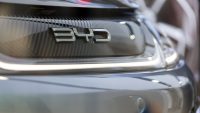 HONDA NSX, a mere cult car? No, it’s more than that: indeed, it’s one of the most significant cars of the past few decades. This sounds like heady praise indeed, but don’t take our word for it.
HONDA NSX, a mere cult car? No, it’s more than that: indeed, it’s one of the most significant cars of the past few decades. This sounds like heady praise indeed, but don’t take our word for it.
That is, instead, the view of McLaren F1 maker and car design god Gordon Murray.
Back in the early 1990s, when McLaren was developing the F1, the firm had targeted all the usual suspects: Ferrari 348, Lamborghini Diablo and so on. The launch of the NSX made all those benchmarks irrelevant.
Here was a machine way ahead of the competition, in terms of drivability, performance, ride comfort, running costs and reliability.
Italian cars? Pah. If you want the best, you need to beat the best. Murray was in no doubt that car was the Honda NSX. He shouldn’t have been surprised, mind. An old McLaren mate of his, Ayrton Senna, had been playing a big role in developing it.
At the Suzuka race circuit, Senna drove prototypes and was instrumental in getting Honda to stiffen the chassis. It was this, coupled with further input from race driver colleagues Satorio Najakima and Bobby Rahal, that made the NSX so imperious.
Nothing less would do for Honda. Borne out of the firm’s ‘New Sportscar eXperimental’ project – hence the name – the NSX followed the archetypal Japanese approach. Decide to do something. Decide on what’s the best out there. And beat it. Initially, that target car was the Ferrari 328, but this later changed to the 348. It still wasn’t enough.
When it was launched in 1990, the NSX simply amazed. It had an all-aluminium chassis, and suspension, and body. It had a 3.0-litre all-alloy VTEC V6 that wailed to a then-outstanding (indeed, still outstanding) 8,000rpm. It’ll do you for 60mph in under six seconds, but it was also a damn sight more economical and emissions-friendly than any Ferrari.
Even better, this wailing performance could be enjoyed every single day of the year. Honda promised total reliability with all its cars, and just because the NSX was a supercar didn’t mean it should be the exception.
VTEC
 Whereas a high-mileage Ferrari would be a terrifying proposition, a 100,000-mile NSX is something that, to coin a phrase, is barely run in. Not for nothing has the firm never, ever had a single warranty claim on its complicated VTEC variable valve timing system…
Whereas a high-mileage Ferrari would be a terrifying proposition, a 100,000-mile NSX is something that, to coin a phrase, is barely run in. Not for nothing has the firm never, ever had a single warranty claim on its complicated VTEC variable valve timing system…
Saving 200kg over a regular chassis, it was Senna’s tuning of the aluminium chassis’ handling that gave the NSX such finesse. Secure and stable, it was scalpel-sharp incisive and packed full of feel.
Supercars tended to lumber before this, all power and brute force over delicacy. The NSX was the first exception that, today, has become the norm. A modern 911 Turbo would not be so magnificent if it wasn’t for the influence of the Honda.
Nor would it be so useable – Honda wisely didn’t copy the awkward, Italianate driving position of its erstwhile rivals. Indeed, the design team is said to have based the cabin, particularly its usability and visibility, on that of the F16 fighter jet.
It was so ahead of its time, Honda didn’t actually do a lot with it after launch. Indeed, save for a larger engine and mild tweaks here and there, the NSX remained unchanged from launch in 1990 to death in 2005. What’s more, the firm has not followed it up.
This only adds to the cult of the brilliant NSX. And rightly so. The first truly idol-worthy Japanese car? The sign-off from Senna guarantees it…
by RICHARD AUCOCK
































